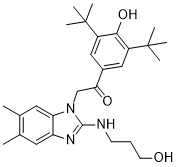| Cas No.: | 758679-97-9 |
| Chemical Name: | CID-2858522 |
| Synonyms: | CID-2858522;1-(3,5-Di-tert-butyl-4-hydroxyphenyl)-2-(2-(3-hydroxypropylamino)-5,6-dimethyl-1H-benzo[d]imidazol-1-yl)ethanone;1-(3,5-ditert-butyl-4-hydroxyphenyl)-2-[2-(3-hydroxypropylamino)-5,6-dimethylbenzimidazol-1-yl]ethanone;1-[3,5-Bis(1,1-diMethylethyl)-4-hydroxyphenyl]-2-[2-[(3-hydroxypropyl)aMino]-5,6-diMethyl-1H-benziMidazol-1-yl]-ethanone;CID 2858522;1-[3,5-Bis(1,1-dimethylethyl)-4-hydroxyphenyl]-2-[2-[(3-hydroxypropyl)amino]-5,6-dimethyl-1H-benzimidazol-1-yl]-ethanone;CID2858522;100844;1-(3,5-di-tert-butyl-4-hydroxyphenyl)-2-(2-(3-hydroxypropylaMino)-5,6-diMethyl-1H-benzo[d]iMidazol-1-yl)ethanone;1-(3,5-Di-tert-butyl-4-hydroxyphenyl)-2-(2-(3-hydroxypropylamino)-5,6-dimethyl-1H-benzo[d]imid;Ethanone, 1-[3,5-bis(1,1-dimethylethyl)-4-hydroxyphenyl]-2-[2-[(3-hydroxypropyl)amino]-5,6-dimethyl-1H-benzimidazol-1-yl]-;CID 2858522,Nuclear factor-kappaB,CID-2858522,NF-κB,Nuclear factor-κB,inhibit,CID2858522,Inhibitor;CBMicro_026940;BDBM50308020;Q27164783;1-(3,5-ditert-butyl-4-hydroxyphenyl)-2-[2-(3-hydroxypropylamino)-5,6-dimethyl-1-benzimidazolyl]ethanone;CHEMBL-374350;AKOS005746877;AB90512;NCGC00370721-09;UNII-Z744D8S6JG;MLS001362415;SMR000855725;MLS001362416;CID2858522, >=98% (HPLC);NCGC00370721-04;CS-1093;HY-15530;Ethanone, 1-(3,5-bis(1,1-dimethylethyl)-4-hydroxyphenyl)-2-(2-((3-hydroxypropyl)amino)-5,6-dimethyl-1H-benzimidazol-1-yl)-;Z744D8S6JG;BCP06877;1-(3,5-di-tert-butyl-4-hydroxyphenyl)-2-(2-(3-hydroxypropylamino)-5,6-dimethyl-1H-benzo[d]imidazol-1-yl)ethanone;CHEBI:93053;ML029;1-(3,5-Di-tert-butyl-4-hydroxyphenyl)-2-(2-(3-hydroxypropylamino)-5,6-dimethyl-1H-benzo(d)imidazol-1-yl)ethanone;1-(3,5-Bis(1,1-dimethylethyl)-4-hydroxyphenyl)-2-(2-((3-hydroxypropyl)amino)-5,6-dimethyl-1H-benzimidazol-1-yl)ethanone;758679-97-9;cid_2858523;DTXSID30386304;AC-37084;F84884;1-[3,5-Bis(1,1-dimethylethyl)-4-hydroxyphenyl]-2-[2-[(3-hydroxypropyl)amino]-5,6-dimethyl-1H-benzimidazol-1-yl]ethanone;1-(3, 5-di-tert-butyl-4-hydroxyphenyl)-2-(2-(3-hydroxypropylamino)-5,6-dimethyl-1H-benzo[d]imidazol-1-yl)ethanone;2-(2-(3-Hydroxypropylamino)-5,6-dimethyl-1H-benzo[d]-imidazol-1-yl)-1-(3,5-di-tert-butyl-4-hydroxyphenyl)ethanone;SCHEMBL1059226;CHEMBL374350;NCGC00370721-05 |
| SMILES: | CC1=C(C)C=C2N=C(NCCCO)N(CC(C3=CC(C(C)(C)C)=C(O)C(C(C)(C)C)=C3)=O)C2=C1 |
| Formula: | C28H39N3O3 |
| M.Wt: | 465.63 |
| Purity: | >98% |
| Sotrage: | 2 years -20°C Powder, 2 weeks 4°C in DMSO, 6 months -80°C in DMSO |
| Description: | CID-2858522 is a highly potent and selective antigen receptor-mediated NF-κB activation inhibitor with an IC50 of 70 nM. |
| In Vivo: | In vivo dose-exposure profiling of CID-2858522 (Compound 1a) is conducted using a small cohort of three male mice. CID-2858522 exhibits nonlinear pharmacokinetics, showing higher serum levels at the 0.5 h measurement time for the 30 mg/kg dose compared to 50 mg/kg but displaying typical dose-dependent behavior when measured at t=3 h. The increasing accumulation seen at a dose of 50 mg/kg may be due to a depot effect created by CYP3A4 inhibition. The cohort exhibits clear signs of morbidity at t=3 h at the 50 mg/kg dose[2]. |
| In Vitro: | CID-2858522 (Compound 1) inhibits antigen receptor-mediated NF-κB with an IC50 of 70 nM. CID-2858522 also inhibits testosterone hydroxylase in the presence of human liver microsomes (HLM) and an NADPH generating system with an IC50 of 85 μM[1]. In the HEK293 cell line used for primary screening, CID-2858522 suppresses NF-κB reporter gene activity in a concentration-dependent manner, with IC50 ~70 nM and with maximum inhibition achieved at 0.25-0.5 μM. In contrast, CID-2858522 does not inhibit TNF-induced NF-κB-reporter gene activity at concentrations as high as 4 μM, thus demonstrating selectivity for the NF-κB pathway activated by PMA/Ionomycin. Cell viability assays indicate that CID-2858522 is not toxic to HEK293 cells at concentrations ≤8 μM. CID-2858522 also potently inhibits PMA/Ionomycin-induced NF-κB reporter gene activity in transient transfection assays[2]. |
| Cell Assay: | Cell viability is estimated based on cellular ATP levels, measured using ATPlite kit. HEK293 cells at a density of 105/mL are seeded at 90 μL per well in 96-well white plates and cultured overnight. Compounds (e.g., CID-2858522; 1 μM, 2 μM, 3 μM, and 4 μM) are added (5 μL in medium) to wells and cells are cultured for 16 h, Finally, 50 μL ATPlite solution is added to each well and luminescence activity is read using a luminometer[2]. |
| Animal Administration: | Mice[2] Three male mice are subjected to CID-2858522 (single ip doses at 10, 30, and 50 mg/kg). Blood is drawn at 0.5 and 3 h, and subsequent LC/MS analysis of pooled samples is performed to determine the overall blood levels of CID-2858522. |
| References: | [1]. Okolotowicz KJ, et al. Selective benzimidazole inhibitors of the antigen receptor-mediated NF-kappaB activationpathway. Bioorg Med Chem. 2010 Mar 1;18(5):1918-24. [2]. Shi R, et al. Chemical biology strategy reveals pathway-selective inhibitor of NF-kappaB activation induced by protein kinase C. ACS Chem Biol. 2010 Mar 19;5(3):287-99. [3]. Peddibhotla S, et al. Inhibition of protein kinase C-driven nuclear factor-kappaB activation: synthesis, structure-activity relationship, and pharmacological profiling of pathway specific benzimidazole probe molecules. J Med Chem. 2010 Jun 24;53(12):4793-7. |

 DC Chemicals' products qualify for U.S. tariff exemptions. We guarantee no price increases due to customs duties and maintain stable supply, continuing to deliver reliable research solutions to our American clients.
DC Chemicals' products qualify for U.S. tariff exemptions. We guarantee no price increases due to customs duties and maintain stable supply, continuing to deliver reliable research solutions to our American clients.





















